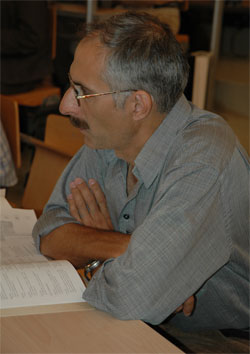LOESSFEST'09 | Aug. 31st – Sept. 3rd, 2009 |Novi Sad-Serbia
14C Ages of Secondary Carbonate Accumulations in Loess-Paleosol Sequences
Pustovoytov, K.1, Mason, J.2, Jacobs, P.3, Stahr, K.1
1University of Hohenheim, Stuttgart, Germany
2University of Wisconsin, Madison, USA
3University of Wisconsin, Whitewater, USA
 Pedogenic or secondary carbonate represents a typical component of loesspaleosol
sequences. Growing interest in pedogenic carbonate is due to the fact
that it can serve as a paleoenvironmental indicator. Carbon isotopic composition
of pedogenic carbonate is controlled primarily by δ13C of soil CO2, which in
turn is strongly related to the photosynthetic pathway of local vegetation. δ18O
values of pedogenic carbonate reflect the 18O/16O ratios of local meteoric water.
There have been several studies addressing the genesis of secondary carbonates
in loess-paleosol sequences. Those works, usually do not involve direct numerical
dating of pedogenic carbonate and its age has been assumed the same as the
age of embedding loess deposit. Here we present the results of radiocarbon dating
of secondary carbonate accumulations from three loess-paleosol sequences. One
of them was located in middle Europe (SW Germany) and two in the USA (the
northern Great Plains). According to OSL dating, the loess deposition took place
in late Pleistocene to mid-Holocene. All measured 14C ages of peodgenic carbonate
were younger than the ages of the embedding loess horizons. Our finding suggests
that secondary carbonate accumulation clearly represents a process superimposed
on loess deposition. This fact should be taken into consideration when
interpreting loess-paleosol sequences as paleoclimate archives.
Pedogenic or secondary carbonate represents a typical component of loesspaleosol
sequences. Growing interest in pedogenic carbonate is due to the fact
that it can serve as a paleoenvironmental indicator. Carbon isotopic composition
of pedogenic carbonate is controlled primarily by δ13C of soil CO2, which in
turn is strongly related to the photosynthetic pathway of local vegetation. δ18O
values of pedogenic carbonate reflect the 18O/16O ratios of local meteoric water.
There have been several studies addressing the genesis of secondary carbonates
in loess-paleosol sequences. Those works, usually do not involve direct numerical
dating of pedogenic carbonate and its age has been assumed the same as the
age of embedding loess deposit. Here we present the results of radiocarbon dating
of secondary carbonate accumulations from three loess-paleosol sequences. One
of them was located in middle Europe (SW Germany) and two in the USA (the
northern Great Plains). According to OSL dating, the loess deposition took place
in late Pleistocene to mid-Holocene. All measured 14C ages of peodgenic carbonate
were younger than the ages of the embedding loess horizons. Our finding suggests
that secondary carbonate accumulation clearly represents a process superimposed
on loess deposition. This fact should be taken into consideration when
interpreting loess-paleosol sequences as paleoclimate archives.



